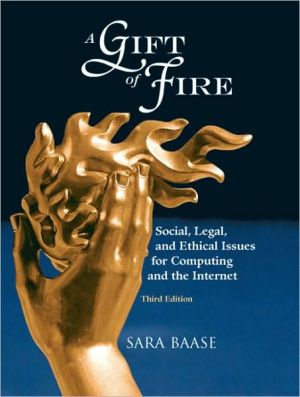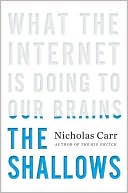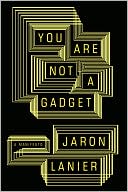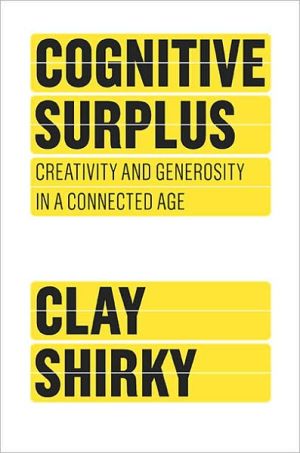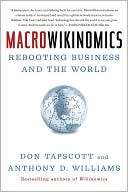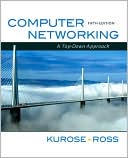A Gift of Fire: Social, Legal, and Ethical Issues for Computing and the Internet, 3rd Edition
A Gift of Fire: Social, Legal, and Ethical Issues for Computing and the Internet \ Third Edition SARA BAASE\ A Gift of Fire, Third Edition is the most comprehensive and up-to-date text on the social and ethical issues associated with computing, networking, and the Internet. Thoroughly updated to reflect the latest trends and technologies, this book will help readers understand and evaluate the crucial issues they will face as technology professionals, users, and citizens.\ Baase offers...
Search in google:
KEY BENEFIT: Baase explores timely social, legal, philosophical, ethical, political, constitutional and economic implications of computing from a computer scientist's perspective. KEY TOPICS: Coverage of the issues readers face both as members of a technological society and as professionals in computer-related fields. Adds new information on phenomena such as the growth of amateur work on the Web, blogs, video sharing, collaborative works (such as Wikipedia), and social networking. Includes new privacy topics such as cameras in cell phones, access to our search queries and all sorts of data we put on the Web, social networking, location tracking, high-tech surveillance systems, and some anti-terrorism programs. Updated chapters on intellectual property, professional ethics and responsibilities, and crime. MARKET: A useful reference for computer science professionals or anyone interested in learning more about computing technology and its arising issues.
Preface Chapter 1 Unwrapping the Gift 1.1 The Ubiquity of Computers and the Rapid Pace of Change1.2 New Developments and Dramatic Impacts1.2.1 Amateur Creative Works: Blogs and Video Sharing1.2.2 Connections1.2.3 Collaborative Efforts Among Strangers1.2.4 E-commerce and Free Stuff1.2.5 Artificial Intelligence, Robotics, and Motion1.2.6 Tools for Disabled People1.2.7 What Next?1.3 An Introduction to Some Issues and Themes1.3.1 Issues1.3.2 Themes1.4 Ethics1.4.1 What Is Ethics, Anyway?1.4.2 A Variety of Ethical Views1.4.3 Some Important DistinctionsChapter 2 Privacy 2.1 Privacy and Computer Technology2.1.1 Introduction2.1.2 New Technology, New Risks2.1.3 Terminology and Principles for Data Collection and Use2.2 Big Brother Is Watching You2.2.1 Databases2.2.2 The Fourth Amendment, Expectation of Privacy, and Surveillance Technologies2.2.3 Video Surveillance2.3 Diverse Privacy Topics2.3.1 Marketing, Personalization and Consumer Dossiers2.3.2 Location Tracking2.3.3 Stolen and Lost Data2.3.4 What We Do Ourselves2.3.5 Public Records: Access vs. Privacy2.3.6 National ID Systems2.3.7 Children2.4 Protecting Privacy: Technology, Markets, Rights, and Laws2.4.1 Technology and Markets2.4.2 Rights and Law2.4.3 Privacy Regulations in the European Union2.5 Communications2.5.1 Wiretapping and E-mail Protection2.5.2 Designing Communications Systems for Interception2.5.3 Secret Intelligence Gathering2.5.4 Encryption PolicyChapter 3 Freedom of Speech 3.1 Changing Communications Paradigms3.1.1 Regulating Communications Media3.1.2 Free-Speech Principles3.2 Controlling Offensive Speech3.2.1 Offensive Speech: What Is It? What Is Illegal?3.2.2 Internet Censorship Laws and Alternatives3.2.3 Spam3.2.4 Challenging Old Regulatory Paradigms and Special Interests3.2.5 Posting and Selling Sensitive Material: Ethics and Social Concerns3.3 Censorship on the Global Net3.3.1 The Global Impact of Censorship3.3.2 Yahoo and French Censorship3.3.3 Censorship in Other Nations3.3.4 Aiding Foreign Censors3.4 Political Campaign Regulations in Cyberspace3.5 Anonymity3.5.1 Common Sense and the Internet3.5.2 Is Anonymity Protected?3.5.3 Against Anonymity3.6 Protecting Access and Innovation: Net Neutrality or Deregulation?Chapter 4 Intellectual Property 4.1 Intellectual Property and Changing Technology4.1.1 What Is Intellectual Property?4.1.2 Challenges of New Technologies4.2 Copyright Law and Significant Cases4.2.1 A Bit of History4.2.2 The Fair-Use Doctrine4.2.3 Significant Cases4.3 Copying and Sharing4.3.1 Defensive and Aggressive Responses from the Content Industries4.3.2 The DMCA vs. Fair Use, Freedom of Speech, and Innovation4.3.3 Video Sharing4.3.4 New Business Models and Constructive Solutions4.3.5 Ethical Arguments About Copying4.3.6 International Piracy4.4 Search Engines and Online Libraries4.5 Free Speech Issues4.6 Free Software4.6.1 What Is Free Software?4.6.2 Should All Software Be Free?4.7 Issues for Software Developers4.7.1 Patents for Software?4.7.2 Patents for Web Technologies4.7.3 Copyright and Similar Software ProductsChapter 5 Crime 5.1 Introduction5.2 Hacking5.2.1 What is Hacking?5.2.2 Hacktivism, or Political Hacking5.2.3 The Law: Catching and Punishing Hackers5.2.4 Security5.3 Identity Theft and Credit-Card Fraud5.3.1 Stealing Identities5.3.2 Responses to Identity Theft5.3.3 Biometrics5.4 Scams and Forgery5.4.1 Auctions5.4.2 Click Fraud5.4.3 Stock Fraud5.4.4 Digital Forgery5.5 Crime Fighting Versus Privacy and Civil Liberties5.5.1 Search and Seizure of Computers5.5.2 The Issue of Venue5.5.3 The Cybercrime Treaty5.6 Whose Laws Rule the Web?5.6.1 When Digital Actions Cross Borders5.6.2 Arresting Foreign Visitors5.6.3 Libel, Speech, and Commercial Law5.6.4 Culture, Law, and Ethics5.6.5 Potential SolutionsChapter 6 Work 6.1 Fears and Questions6.2 The Impact on Employment6.2.1 Job Destruction and Creation6.2.2 Changing Skill Levels6.2.3 A Global Workforce6.2.4 Getting a Job6.3 The Work Environment6.3.1 Job Dispersal and Telecommuting6.3.2 Changing Business Structures6.4 Employee Monitoring6.4.1 Background6.4.2 Data Entry, Phone Work, and Retail6.4.3 Location Monitoring6.4.4 E-mail, Blogging, and Web UseChapter 7 Evaluating and Controlling Technology 7.1 Information, Knowledge, and Judgment7.1.1 Evaluating Information on the Web7.1.2 Writing, Thinking, and Deciding7.1.3 Computer Models7.2 Computers and Community7.3 The Digital Divide7.4 Evaluations of the Impact of Computer Technology7.4.1 The Neo-Luddite View of Computers, Technology, and Human Needs7.4.2 Accomplishments of Technology7.5 Making Decisions about Technology7.5.1 Questions7.5.2 The Difficulty of Prediction7.5.3 Intelligent Machines and Superintelligent Humans – Or the End of the Human Race?7.5.4 A Few ObservationsChapter 8 Errors, Failures, and Risk8.1 Failures and Errors in Computer Systems8.1.1 An Overview8.1.2 Problems for Individuals8.1.3 System Failures8.1.4 Safety-Critical Applications8.1.5 Perspectives on Failure8.2 Case Study: The Therac-258.2.1 Therac-25 Radiation Overdoses8.2.2 Software and Design Problems8.2.3 Why So Many Incidents?8.2.4 Observations and Perspective8.3 Increasing Reliability and Safety8.3.1 What Goes Wrong?8.3.2 Professional Techniques8.3.3 Law, Regulation, and Markets8.4 Dependence, Risk, and Progress8.4.1 Are We Too Dependent On Computers?8.4.2 Risk and ProgressChapter 9 Professional Ethics and Responsibilities 9.1 What Is Professional Ethics?9.2 Ethical Guidelines for Computer Professionals9.2.1 Special Aspects of Professional Ethics9.2.2 Professional Codes of Ethics9.2.3 Guidelines and Professional Responsibilities9.3 Scenarios9.3.1 Introduction and Methodology9.3.2 Protecting Personal Data9.3.3 Designing an E-mail System with Targeted Ads9.3.4 Specifications9.3.5 Skipping Tests9.3.6 Copyright Violation9.3.7 Going Public9.3.8 Release of Personal Information9.3.9 Conflict of Interest9.3.10 Kickbacks and Disclosure9.3.11 A Test Plan9.3.12 Artificial Intelligence and Sentencing Criminals9.3.13 A Gracious HostEpilogue A The Software Engineering Code and the ACM Code A.1 The Software Engineering Code of Ethics and Professional PracticeA.2 The ACM Code of Ethics and Professional ConductIndex
